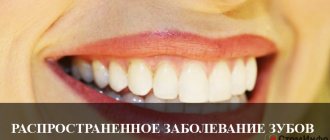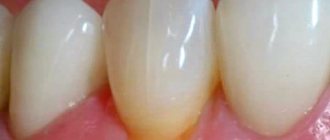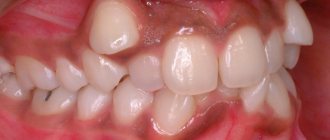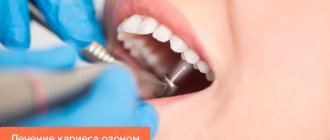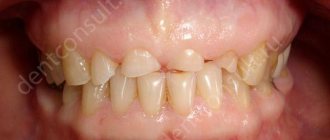Causes
Let's look at the causes of dental cancer
:
- Oral injuries of various origins. Poor-quality dentures rub the gums; the presence of piercings in the tongue or lip can cause inflammation
- Bad habits (smoking, drinking alcohol and drugs).
- Untreated caries.
- Inflammatory diseases of soft tissues.
- Herpes virus, HPV, Bowen's disease.
- Poor oral hygiene.
- Hot or spicy foods that constantly irritate the mucous membranes.
- Work in conditions harmful to health (hot workshop, dusty room).
- A history of cancer of the stomach, kidneys and lungs. In this case dental cancer
is a secondary pathology.
To take care of your health, rule out dental cancer, causes
its development must be monitored. Careful oral care, eradication of bad habits, and regular visits to the dentist will reduce the risk of developing pathology.
Stages of pathology development
Dental cancer
Like any cancer, it occurs in the human body through four stages:
- The first stage is when the tumor is within 10 mm. The place of formation is the mucous membrane or tooth germ.
- The second stage is when the tumor reaches 3 cm. The symptoms of cancer become more obvious. Metastasis is found in one of the regional lymph nodes.
- Stage three – the tumor exceeds 3 cm in size. Metastases are detected in several regional lymph nodes.
- The fourth stage is when the process becomes aggressively malignant, affecting the oral cavity, nose, and also the base of the skull. Metastases may be found in the lungs and liver.
Types of malignant dental tumors, stages of the pathological process
Pathological neoplasms of teeth are quite rare. Even less often, they transform into malignant tumors. Cancer of the oral cavity - tongue, gums, mucous membrane, pharynx - is much more common in medical practice.
In the medical literature, the following types of dental tumors are distinguished:
Adamantinoma
Among odontogenic malignant neoplasms, it is the most common. It is detected in people aged 20-40 years.
The nature of the appearance of the disease in question has not been precisely established, but there is a version that the source of tumor development is the tooth germ, incl. remains - dental plate at different stages of tooth formation.
This tumor grows very slowly: in medical practice there have been cases when people sought qualified help only 20-25 years after the appearance of adamantinoma.
Its consistency is soft with a yellow liquid inside. The molars of the lower jaw are often affected, and much less often the upper teeth. When a tumor grows in the upper jaw, the bone tissue of the jaw and paranasal sinuses are drawn into the pathological process, and in advanced stages the brain is affected. Adamantinoma of the lower jaw, as a rule, grows outward, destroying the soft tissues of the oral cavity.
Video: Adamantinoma
There are two types of adamantinoma:
- Solid tumor . It is also called massive or solid. Such a neoplasm is delimited from the bone tissue by a capsule. Externally, it can be smooth or slightly embossed.
- Cystic tumor . It develops as a result of destruction of the epithelium of a continuous tumor, which provokes the appearance of cysts lined with a thin epithelial membrane. Often many such cysts form, which is why this type of adamantinoma is sometimes called polycystoma. Inside these cavities are filled with yellow liquid. In rare cases, only one cyst may form.
These two types of adamantinoma should not be considered as two separate entities. They are characterized by stages : a massive tumor in advanced stages leads to the formation of a cystic tumor.
In its development, the disease in question goes through 4 stages:
- Stage I. The neoplasm is limited to bone tissue and is low-grade in nature.
- Stage II. The degree of malignancy here is high, but metastasis is not observed. The disease process involves a tooth and a small area of gum.
- Stage III. The tumor actively increases in size, spreading to nearby tissues.
- Stage IV. Cancer cells spread to regional lymph nodes and distant organs.
Odontoma
In general, it is a benign tumor, but in rare cases, soft odontoma can transform into a malignant neoplasm.
The formation of such a tumor is associated with the period of formation of tooth buds, so soft odontoma is often diagnosed in children. When the cortical plate is destroyed, this neoplasm spreads to the soft tissues, protruding into the oral cavity. Most often, the type of dental tumor in question is localized on the lower jaw in the molar area.
There are also other types of dental tumors: cementoma and odontogenic fibroma , but they are not prone to malignancy.
As for odontoma, the process of its transformation into a malignant neoplasm is an extremely rare phenomenon. Therefore, when talking about dental cancer, as a rule, it is adamantinoma of the tooth that is meant.
However, the lack of proper treatment for any of the above tumors can provoke a number of unpleasant complications, including disruption of the respiratory system, jaw deformation, infectious lesions, etc.
Video: Odontoma
Symptoms of tooth cancer
Oncology in the initial stages has hidden symptoms and can develop over years and decades. Gradually the symptoms begin to manifest themselves:
- A formation of soft consistency to the touch appears on the jaw, convex in shape, increasing in size over time.
- The dentition may become deformed and the teeth become mobile.
- Pain sensations increase. It becomes difficult for a person to eat, chew, and swallow.
- Regional lymph nodes increase in size.
- A man loses weight.
- Low-grade body temperature, which periodically rises.
- Fistulas in tissues.
- When pressing on the tumor area, the doctor may feel a crunching sound.
- The enamel becomes fragile and is destroyed very easily.
In the prevention of dental cancer symptoms
may not appear, but it is important to visit your doctor regularly. Identified disease in the early stages provides a better prognosis for treatment. Late stages are dangerous for metastasis to other organs.
Diagnostics
The main measures for identifying dental cancer are based on the patient’s complaints, external examination data, X-ray images and histological examination.
During the examination, the attending physician may detect deformation and asymmetry of the face, the presence of ulcers near the problematic tooth. Often, the patient feels a burning sensation, numbness or tingling in the area of the disease.
Palpation reveals thickening of bone tissue. The affected teeth begin to loosen. When cancer cells spread, inflammation and pathological growth on the gums are detected. X-rays show rarefaction of bone tissue.
On this topic
- Oncostomatology
The first signs of jaw cancer
- Olga Vladimirovna Khazova
- February 25, 2020
To make an accurate diagnosis, a biopsy is performed from the surface of the ulcerative formations.
Today, cancer screening in dentistry is considered the most modern method for diagnosing malignant tumors in the oral cavity. For the purpose of this study, the doctor gives the patient a rinse solution.
After that, putting on glasses, he directs a beam of light from a special flashlight device to the problem areas. The composition of the solution and lighting, interacting with each other, indicate the presence of even very small pathological foci on the teeth or gums.
Tooth cancer is differentiated from chronic osteomyelitis and other benign tumors.
Treatment of tooth cancer
When the doctor confirms dental cancer, symptoms
which prompted you to come to the appointment, it is necessary to begin treatment as soon as possible. The most effective method is surgical removal of the tumor within healthy tissue. In the early stages of the process, the tumor is removed along with the teeth and part of the jaw.
In other cases, the jaw is resected completely or partially, and regional lymph nodes are removed. Based on the results of diagnosing the type of tumor and the stage of the process, chemotherapy or laser therapy is prescribed before surgery in order to reduce the tumor in size.
In the first and second stages, the prognosis is favorable: 80% of people survive the 5-year mark. In the third stage of the disease, more than half of people survive five years. In the fourth stage, only 15% reach the five-year survival mark. Regular preventive examinations and adherence to healthy lifestyle standards can reduce the risk of disease.
Dental treatment for oncology
Dental treatment for cancer is associated with difficulties. During chemotherapy and radiation therapy, the body suffers from various side effects. Dental treatment becomes additional stress for a person. The gold standard before starting cancer therapy is oral hygiene, as the body will be less able to resist bacteria during cancer treatment.
Neoadjuvant and adjuvant therapy
Often, especially in stages II–III of cancer, radical surgery alone is not enough. It is complemented by other types of treatment:
- Neoadjuvant therapy is given before surgery and helps shrink the cancer, making it easier to remove. Sometimes, after neoadjuvant therapy, inoperable cancer becomes resectable.
- Adjuvant therapy is carried out after surgery. It helps destroy remaining cancer cells and reduce the risk of recurrence.
Chemotherapy, radiation therapy, targeted therapy, immunotherapy, and hormone therapy are used as adjuvant and neoadjuvant treatment.
Treatment and removal of teeth in cancer patients
In cancer patients, during the treatment of the underlying disease, favorable conditions are created in the oral cavity for the proliferation of pathological microorganisms. Irradiation inhibits cell growth, including in the oral cavity.
The task of a dentist in the treatment of teeth and oncology
the patient is not to harm him. Despite the fact that the body is weakened by a serious illness and no less severe therapy, caries must be treated so that it does not turn into pulpitis. Due to weakened immunity in cancer patients, inflammation progresses rapidly if left untreated. When treating teeth, it is important that the doctor knows the number of leukocytes, blood coagulation status, uses low-traumatic techniques, and coordinates the procedure with the oncologist.
Tumor localization outside the head and neck
If the cancer is located outside the maxillofacial area, this is a very conditional contraindication to orthopedic treatment. The decisive factors here are the nature of the neoblastoma formation and the treatment taken in connection with it.
The main concerns in this case may be related to a violation of the blood clotting process. Very often, to prepare a patient for removable or fixed prosthetics, it is necessary to resort to preliminary surgical preparation, which is necessarily accompanied by local bleeding.
If a tumor disease affects the hematopoietic system, or the patient receives radiation during treatment, blood clotting is significantly impaired. As a result, this can lead to local bleeding that poses a great threat to the patient’s life. Therefore, in such cases, manipulations associated with rupture of blood vessels should be avoided whenever possible.
Separately, you should learn about tumor diseases of the bones and breast cancer with metastases to bone tissue before planning surgical preparation. The fact is that very often such patients are treated with drugs from the bisphosphonate group. Long-term use of bisphosphonates leads to the fact that extensive bone necrosis may occur during tooth extraction or preparation of the alveolar ridge for a prosthesis.
If dental prosthetics for oncology is carried out against the background of immunosuppression or therapy that suppresses the immune system, you should work very carefully when preparing and forming the basis of the prosthesis. The formation of microtraumas and rubbing in this case can lead to long-term non-healing lesions.
Chemotherapy and tooth extraction
Teeth that cannot be restored are subject to removal. Although patients receiving chemotherapy have a weakened immune system, the consequences of refusing to remove an inflammatory tooth are much more serious than the side effects of anticancer therapy. It is advisable to remove teeth before starting chemotherapy.
in dental treatment
is taken into account, the doctor takes into account the patient’s condition when choosing an intervention technique. Treatment by a dentist during chemotherapy is not advisable, but if there is an emergency and the patient is already taking chemotherapy, the intervention of a doctor will avoid big problems. Removal should be done as atraumatically as possible.
Dental problems and dental treatment for oncology
After chemotherapy, many are faced with the fact that they develop caries, gingivitis, stomatitis, periodontal disease, cysts begin to form, gums become more sensitive and bleed.
This condition creates additional difficulties for the dentist, but does not mean that you need to refuse dental treatment, cancer
not prevent. It is important to tell your dentist about your diagnosis and that you are currently undergoing treatment for cancer. This will allow him to choose the most gentle methods for solving dental problems.
You need to know that when treating teeth, oncology
does not progress and the disease itself is not a contraindication to dental intervention. Dental treatment will remove the source of infection, prevent its further spread, and defeat cancer.
Dental treatment of patients during chemotherapy and radiotherapy: review of clinical approaches
Dental treatment for people suffering from cancer is not without difficulties. At the same time, getting rid of dental ailments is necessary. After all, diseased teeth are a source of bacteria.
In the arsenal of a modern dentist there are many technologies and methods of treatment and dental prosthetics - the prices, varieties and features of each of them are different.
In this case, only a doctor can decide which treatment to give preference in each specific case.
This decision is made based on information about the problems and characteristics of the patient’s oral cavity, as well as his general health.
Dental treatment is especially difficult if the patient has cancer. At the same time, complete sanitation of the oral cavity in such patients is necessary. After all, caries and unhealthy teeth are a source of bacteria and viruses that are dangerous even for a healthy person.
Stomatitis as a complication of treatment for cancer and head tumors
This is a generalized name for inflammation of various origins of the oral mucosa, which have common symptoms.
Decreased salivary secretion associated with suppression of the secretory function of the salivary glands.
Opportunistic infections - herpetic stomatitis, thrush and deep forms of mycosis, radiation caries and associated pulpitis, periodontitis.
Necrotization of various parts of the alveolar process and areas of the upper and lower jaws.
The appearance of these side effects from the main therapy forces a change in the treatment regimen and reduces its effectiveness. Subsequently, patients are faced with the need for rehabilitation of the dento-maxillary apparatus.
Most problems are caused by inflammation of the oral mucosa ( stomatitis ).
This applies to approximately 80% of patients treated with chemotherapy, 20-40% of patients with conventional chemotherapy, and approximately 50% of patients with radiotherapy to the neck or head.
In addition, one cannot ignore the fact that stomatitis causes very severe pain, which accompanies inflammation of the oral mucosa; sometimes the pain itself requires the prescription of additional painkillers, including opioids. This leads to the conclusion about the importance of a preventive approach to the problem and early diagnosis, in which the dentist plays the main role.
Stomatitis in a patient with cancer treated with cytostatics
The goal of oncostatic drugs is to block rapidly dividing tumor cells in the S phase of DNA synthesis. Unfortunately, not only cancer, but also healthy cells in the oral mucosa also slow down their division.
e week after administration of the drug, changes in the basal layer of the epithelium can be observed. Damaged DNA strands in cells begin a cascade of inflammatory reactions.
Preliminary irritation of the mucous membrane sharply worsens the situation, which leads to ulceration (apoptosis), further tissue destruction is enhanced by metabolic products of bacteria in the mouth.
The direct effects of cytotoxic drugs are indirectly enhanced by the consequences of the bone marrow response to chemotherapy - anemia, thrombocytopenia, leukopenia, and, above all, a general reduction in the number of neutrophils.
Radiation therapy is also important for cells in the process of proliferation, as well as in a state of rest. The risk of toxic effects of cancer therapy increases when radiation therapy is combined with chemotherapy.
The severity of the changes varies between individuals and depends not only on the radiation dose, but also on the patient's age and genetic predisposition.
The most susceptible cells are the epithelium of the red border of the lips, cheeks, mucous membrane of the soft palate, and throat.
Four levels of severity of lesions can be distinguished:
- Erythema, no pain or moderate tenderness;
- Erythema with superficial erosions, pain, but solid food can be taken;
- Erythema, deep erosions, inability to take solid food.
- Vasflammatory changes and necrotic plaque cover the entire mucous membrane of the mouth, throat and esophagus, and there is a need for parenteral nutrition.
Stomatitis during chemotherapy, radiotherapy, methods of its prevention
It is not uncommon for cancer patients to be surprised by the information that when oncology is diagnosed, treatment with anticancer drugs or bone marrow transplantation can lead to serious complications in the oral cavity that threaten his health, life, and transplant rejection.
The side effects of chemotherapy and/or radiation therapy can only be prevented through proper preparation of the patient's oral cavity and his full awareness of prevention and strict oral hygiene.
to begin hygienic preventive measures at least two weeks before the first chemotherapy.
We recommend starting three weeks before the patient begins receiving primary therapy. Also in the case of radiation therapy, treatment should begin at least 14 days before irradiation (the necessary period for wound healing after any manipulation in the oral cavity).
Already during oncological therapy, any dental procedures are highly undesirable (except in very justified emergency cases and under the close supervision of an oncologist).
Fungal infections in cancer patients after X-ray surgery
Diagnosis of dental problems if cancer is being treated:
- Based on an x-ray panoramic examination, exclude all sources of infection: remove the roots of the teeth, remove the pulp from teeth that may cause problems in the short term (destroyed and with deep caries, with pronounced manifestations of periodontitis).
- Remove all sources of possible trauma (it is necessary to smooth the sharp edges of the incisors, remove supragingival and subgingival dental plaque).
- Treatment of any form of gum inflammation.
- Completely remove third molars with the risk of developing pericoronitis.
- Restore damaged tooth crowns with high-quality fillings or using tooth crowns, preferably made of metal-free ceramics.
- Remove braces to prevent trauma to the mucous membrane.
- It is advisable to make new removable dentures, taking into account the adaptation time of at least 3 months.
Oral hygiene cancer treatment complications of therapy
- Proper instruction in daily oral hygiene can effectively reduce the severity and duration of inflammatory lesions of the oral mucosa, and also reduces the risk of developing superinfections, including opportunistic ones.
We recommend using a soft or very soft toothbrush during the treatment period. Toothpaste should not contain sodium lauryl sulfate, which irritates mucous membranes and interferes with wound healing. It is recommended to brush your teeth after every meal. After brushing, it is better to use saline solution to rinse your mouth. - Irrigation (without restrictions) during the day it is also advisable to use saline solution.
It does not irritate the mucous membrane, improves blood circulation and nutrition of the mucous membrane itself. Frequent mouth rinses with saline or baking soda moisturize the mucous membrane, cleanse, heal damage to the mucous membrane, reduce inflammation, inhibit plaque accumulation, and wash away or thin out thick and sticky mucous secretions.It is forbidden to use ready-made rinses containing alcohol or H 2 O 2, which can cause irritation of the mucous membranes and increase the feeling of dryness. Flossing should be done once a day, preferably with waxed thread. If there is bleeding from the papillae, you should pause for two or more days.
- The red border of the lips should be covered with a nourishing cream.
- Patients with removable dentures should, if possible, not use them during the treatment period.
When this is not possible, they should be removed at night. Dentures should be thoroughly cleaned every day using appropriate disinfectant solutions. Any sign of stomatitis should be considered a superinfection of Candida Albicans, and it is this fungal flora that colonizes the pores and microdefects of a removable denture during its wear.
How to prevent the disease?
Patients who do not maintain oral hygiene are most susceptible to the disease. At risk are people who suffer from chronic diseases of the throat and teeth. Constant stress, depression and vitamin deficiency can cause ulcers to appear.
To prevent the disease, it is important to undergo a timely examination by a dentist, rinse your mouth after meals, carefully brush your teeth and change your brush every 3-4 months, buying a hygiene product with soft bristles. If there are dental problems, they need to be eliminated before taking medications; the following rules will help with this:
- brushing your teeth for at least 3-5 minutes;
- If your platelet count is low, dental floss should not be used;
- choosing a paste containing silicon dioxide, containing fluorides and antiseptics;
- Irrigation of the mouth with rinses with chlorhexedine, eludril;
- rinsing with decoctions of St. John's wort, sage, calendula, chamomile.
To prevent stomatitis, you need to follow a diet. Spicy, sour, salty foods and alcohol should be excluded from the diet. The amount of water consumption should be 1.5-2 liters per day. Non-acidic fruits, berries, and melons help moisturize the mouth.
Dietary recommendations if cancer is diagnosed
You should limit your intake of simple sugars or replace them with aspartame, acesulfame, sorbitol or xylitol. Consumption of foods with spicy spices that irritate the mucous membrane should be limited.
Preferred food is warm and with mild aromas, with minimal amounts of spices. Avoid fruit juices, particularly sour fresh fruits, both because they taste too strong and because of the risk of enamel erosion.
Reduce consumption of coffee, tea and thirst-causing foods (dry biscuits, crackers, chips). Alcohol in any form should be excluded from the diet.
It should be borne in mind that maintaining a balanced diet in patients undergoing chemotherapy and/or radiation therapy poses specific difficulties. There is a change in taste, difficulty swallowing, and nausea and vomiting may occur.
In addition, drugs recommended during treatment have an adverse effect on some food ingredients, drugs such as neomycin reduce the absorption of vitamins K and D, methotrexate, in general, affects the metabolism of vitamins, in particular, it reacts with folic acid and most drugs can lead to anorexia.
Nutritional compositions available in pharmacies, in liquid form, containing a set of vitamins, microelements and amino acids that provide calories and nutrients, should complement the daily diet of cancer patients.
In the case of stomatitis, the most effective drugs are oil-based keratoplasties - aecol, vitamin A, E. But their healing effect is not high, these drugs are nothing more than vitamins.
EGF Epidermal growth factor. Belongs to the group of polypeptides.
Only a few of its forms are approved for use in Russia; in particular, it is offered by the Moscow company REPLERY in the form of a spray for application to the mucous membrane or skin.
The wound healing effect is very high, as is the cost of the drug. It is still used in medicine to a limited extent, but is very widely represented in cosmetology and is included in many cosmetic preparations.
Palifermin is a recombinant human keratinocyte growth factor, a drug close to EGF, certified and used in the European Union
SUMMARY
Prevention of stomatitis in every patient with cancer should be part of therapy. It has a chance of success only due to the proper motivation of the patient himself, his desire and self-discipline.
Of course, if a person has cancer, if the doctor sees symptoms of cancer in the mouth, then a request to replace a filling or install prosthetics causes a sarcastic smile in the patient.
In addition to unpleasant sensations, there are also expenses, and cancer treatment itself is not cheap.
And then these dentists start the old boring song about the need to have clean teeth. But it should be recalled that dental problems are one of the provoking factors for the occurrence of cancer. Those. Many ended up at the oncologist precisely because of untreated teeth.
And in our practice, we have encountered similar cases. In particular, I remember a case when we diagnosed a patient with cancer that developed under an old removable denture. This was malignancy of the area of the mucous membrane under the prosthesis with deep ulceration and reaction of the regional lymph nodes, classic leukoplakia. Our diagnosis was subsequently confirmed.
But even if the disease does appear, oncologists have developed effective treatment regimens and practice has shown that they are successful in most cases. But oncologists themselves admit that it is not always possible to fully carry out therapy due to the occurrence of complications associated with concomitant diseases.
Any therapy for cancer, and indeed all tumors, is based on one basic principle. Tumor cells are in the stage of constant, avalanche-like division and in this state they have one vulnerability - they are sensitive to X-rays and cytostatic drugs.
Source: https://PlastikaPlus.ru/desny/lechenie-zubov-pri-onkologii.html



